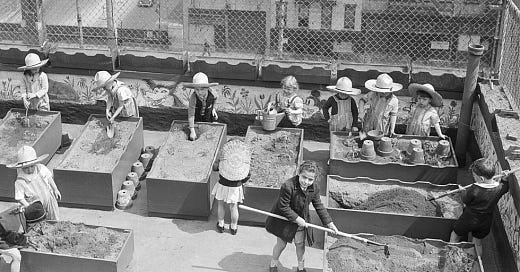My day job is investing in advanced agricultural and food technology. However, I believe there is an equally important low-tech climate breakthrough in the food space—one that has been around for a hundred years: planting victory gardens.
It is a straightforward idea that was used a century ago to help the Allies win the World Wars. The widespread call for “Victory Gardens” asked citizens to plant crops in their yards, rooftops, and neighborhoods to secure the food supply for the fight against fascism. Now, it is time to bring them back to take on climate change–the great war of our generation. This coming Spring, let’s plant Climate Victory Gardens.
During the First and Second World Wars, equally important as Rosie the Riveter’s bombs were maintaining robust supply chains for food and everyday essentials. As President Woodrow Wilson said in 1917: “food will win the war”. Alongside rationing, home gardening was both a patriotic act and a practical necessity with nearly half of Americans gardening during WW2. Twenty million gardens were planted in backyards, sports fields, public parks, city rooftops, and even the White House lawn, accounting for up to 40% of the nation’s produce supply–10 billion pounds worth–in the early 1940s.
To achieve this, the federal government put serious resources into promoting gardening by coining the term “Victory Gardens” then engaging in educational and promotional campaigns while easing regulations on land use. Kids and adults alike were reportedly happier and healthier engaging in the work which was often community-oriented in shared garden plots in vacant urban lots or parks.
Now, we find ourselves fighting a new axis: climate change, lifestyle disease, inflation, and pandemics all growingly afflict society. How we produce food is a massive contributor to all these issues. Our agricultural system accounts for 26-34% of all greenhouse gas emissions while becoming increasingly less micronutrient dense, more globalized, and more reliant on chemical fertilizers, pesticides, hormones, and antibiotics. The large row crop monocultures and factory farms that the industrial food system relies on are not only worse for health and the environment, but are susceptible to crop blights, animal influenza, input price shocks, and global supply disruptions like COVID-19. A social movement re-popularizing Victory Gardens could address these issues simultaneously by drastically increasing the amount of fresh, biodiverse, nutrient-dense home-grown and community-grown vegetables, fruit, and even eggs and poultry. Climate Victory Gardens could also promote physical activity and social cohesion in a nation that is already “too online.”
There was a surge in gardening interest during the COVID-19 pandemic (amid some calls for “COVID Victory Gardens”), but the concept never got quite as much buzz as the newest HBO series or pickleball. Maybe adding climate action to pandemic preparedness, increased food sovereignty, and better health outcomes will motivate families and governments alike to take gardening a bit more seriously.
Planting a Climate Victory Garden can be as simple as herbs in a windowsill and mushrooms in a closet or as complex as a backyard chicken coop and a cooperative agroforest orchard. The size of the gardens are less important than the act of planting–of making the connection between locally grown-food, climate, health, and food security. Most people wrongly believe that their diet is not a major contributor to climate change, but it is actually the single most potent climate (and health) solution available to all of us. In a culture that is so far-removed from food production we forget the power of gardening and how it can bring us wellness and togetherness. Gardening is for everyone; it can't be defined as urban, rural, conservative, progressive, old, or new. It can be done cheaply–with seeds from grocery produce and compost from food scraps–even on the tiniest scale. Both seeds and canned produce can be stored for years, or better yet shared with neighbors.
If we rally around the idea of Climate Victory Gardens–if we take back just a small bit of our own responsibility when it comes to food production–it could heal our bodies, our communities, and our climate doom-ism. If the government supports the concept like it did during the World Wars, that could provide a huge boost to the cause.
Even if the government decides to ignore home gardening in favor of flashier infrastructure projects and more commodity agriculture, we can plant our own grassroots or guerilla Green New Deal. Let’s normalize sharing seeds, best practices, equipment, and even land or produce with our community of fellow Climate Victory Gardeners. Let’s expand farmers markets, seed banks, plant swaps, and educational extension offices. It will benefit ourselves, our children, our communities, and maybe even save our climate. Spring is coming!
This is Fifth Industrial, a blog scouting emerging environmental biotechnologies and strategies for a regenerative economy. See the posts on the most impactful bioproducts, plant cell culture, cellular agriculture, mycelium materials, synthetic silk, microbiomics, deep space food, alt cheese, alt protein CPG, biophilia, and agricultural innovation engines.
Please support by subscribing (it’s free) and sharing.







Love the concept of revamping victory gardens. In an era where agriculture is highly centralized – and its negative externalities threatening future food production – growing our own food is a revolutionary act.
It also doesn't necessarily take that much space. Using highly space-efficient methods like permaculture, 800 sqft could suffice to feed a family of 4 year-round. The caveat is: it requires a few hours of work a day.